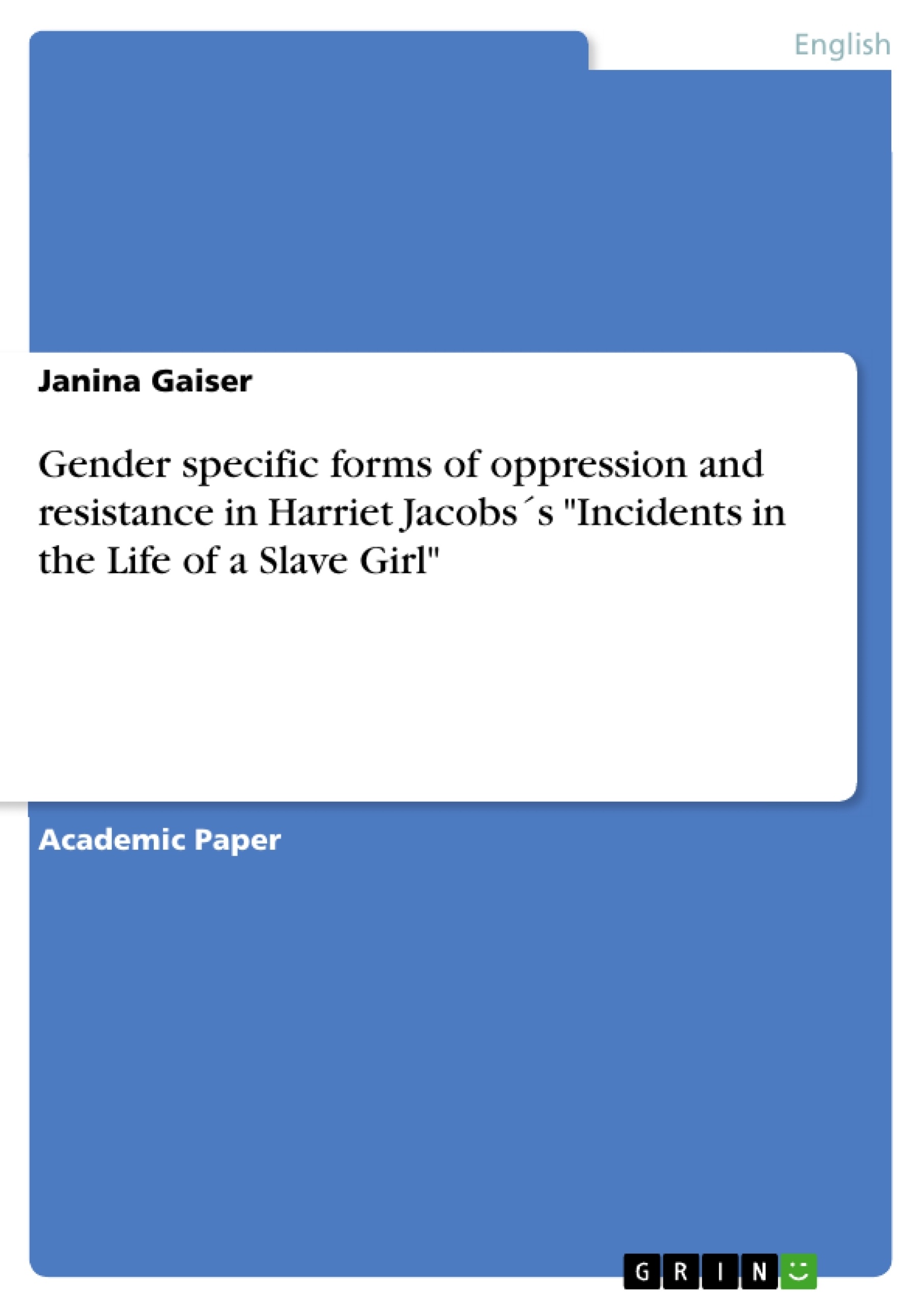“You have seen a man made a slave; you shall see how a slave was made a man.” (Douglass, Jacobs, 2004) The experiences of Frederick Douglass, one of the former slaves who escaped the horrors of slavery, became one of the most widely read slave narratives and the most influential African- American text of the antebellum era. Authors like Douglass wanted not only to expose the inhumanity of the slave system, but they also gave incontestable evidence to the humanity of the African American. The question that arises is, how representative Douglass ́s narrative is – does he speak of “man” as a representative for people in general, or is he specifically speaking for the male slave?
For the last years scholars have begun to pay more attention to issues of gender in their study of slavery and claim that female slaves faced additional burdens and even more challenges than some of the male slaves.
Based on the first female slave narrative, Harriet Jacobs ́s Incidents in the Life of a Slave Girl, this paper will investigate how gender influences the way in which bondage can be experienced differently: what specific forms of oppression do women face in slavery, or what forms of oppression do they encounter to a larger extent than men? Claiming that this gender specific oppression results in gender specific forms of resistance, I will furthermore focus on the ways of how female slaves made a stand against this oppression. Again, Jacobs ́s narrative will be the basis for this investigation.
Incidents is the first-person account of Jacobs ́s pseudonymous narrator “Linda Brent” and presents an accurate, although selective, story of her life. This paper will not discuss the relationship between Jacobs and her narrator Brent, but will consider Brent ́s account as autobiographical for Jacobs. For over a century, the authenticity of Jacobs ́s experiences was questioned until Jean Fagan Yellin ́ s ground breaking work proved her authorship.
The basis for the following investigation will be a brief introduction of the various ways of approaching Incidents.
The second part of the paper will then consider two gender specific forms of oppression: patriarchal sexual oppression, and the deprival of identity by neglecting female slaves to live out the “virtues of womanhood”. With Incidents, Jacobs breaks taboos in order to present Brent ́s sexual history in slavery and to emphasize the power of self-determination, motherhood and family relationships as powerful weapons of resistance.
Table of Contents
- INTRODUCTION
- PART I
- I.1 WAYS OF READING INCIDENTS
- PART II
- II.1 PATRIARCHAL SEXUAL OPPRESSION
- II.2 RESISTANCE THROUGH SELF-DETERMINATION IN SEXUALITY
- II.3 LIMITATIONS OF RESISTANCE AGAINST PATRIARCHAL SEXUAL OPPRESSION
- II.4 OPPRESSION THROUGH THE DEPRIVAL OF FEMALE IDENTITY BY NEGLECTING SLAVE WOMEN TO LIVE OUT THE "VIRTUES OF WOMANHOOD"
- II.5 RESISTANCE BY REDEFINITION OF SELF-DETERMINATION THROUGH MOTHERHOOD
- II.6 OPPRESSION THROUGH THE DESTRUCTION OF RELATIONSHIPS
- II.7 RESISTANCE BY BUILDING STRONG RELATIONSHIPS AND COMMUNITIES
- II.8 RESISTANCE BY CALLING FOR POLITICAL ACTION
- II.9 LIMITATIONS OF RESISTANCE AGAINST THE DEPRIVAL OF IDENTITY AND THE DESTRUCTION OF RELATIONSHIPS
- PART III: JACOBS´S OPPRESSION AND RESISTANCE AS AN AUTHOR
- III.1 EDITORIAL OPPRESSION AND JACOBS'S RESISTANCE
- III.2 LITERARY OPPRESSION AND JACOBS´S RESISTANCE
- PART IV: LIMITATIONS OF RESISTANCE - HOW SUCCESSFUL IS JACOBS´S RESISTANCE?
Objectives and Key Themes
This paper examines the specific forms of oppression faced by women in slavery as depicted in Harriet Jacobs's Incidents in the Life of a Slave Girl. It explores how these forms of oppression differ from those experienced by male slaves and how female slaves resisted these challenges. The main goal is to highlight the unique experiences of female slaves and their strategies for achieving self-determination and resisting oppression.
- Gender-specific oppression within slavery
- Forms of resistance against these specific forms of oppression
- The role of motherhood and family relationships in resistance
- Jacobs's struggle as an author and the limitations she faced in publishing her work
- The significance of Incidents as a "female version" of the slave narrative
Chapter Summaries
The introduction provides context by highlighting the significance of Frederick Douglass's narrative and the growing recognition of gendered experiences within slavery. It introduces Harriet Jacobs's Incidents as the first female slave narrative and sets the stage for investigating the unique challenges faced by female slaves. The first part delves into different ways of reading and interpreting Incidents, examining critical perspectives that highlight its political and social implications. It also explores recent scholarship that focuses on "small" acts of resistance, emphasizing the importance of space and the body as sites of agency. The second part investigates two key forms of gender-specific oppression: patriarchal sexual oppression and the denial of female identity. It analyzes how Jacobs uses her personal story to challenge traditional notions of womanhood and explore how female slaves resisted these forms of oppression.
Keywords
The main keywords and focus topics of this paper include: gender-specific oppression, slave narratives, female agency, self-determination, motherhood, family relationships, literary resistance, Incidents in the Life of a Slave Girl, Harriet Jacobs, and African American literature.
- Arbeit zitieren
- Janina Gaiser (Autor:in), 2015, Gender specific forms of oppression and resistance in Harriet Jacobs´s "Incidents in the Life of a Slave Girl", München, GRIN Verlag, https://www.hausarbeiten.de/document/415670


